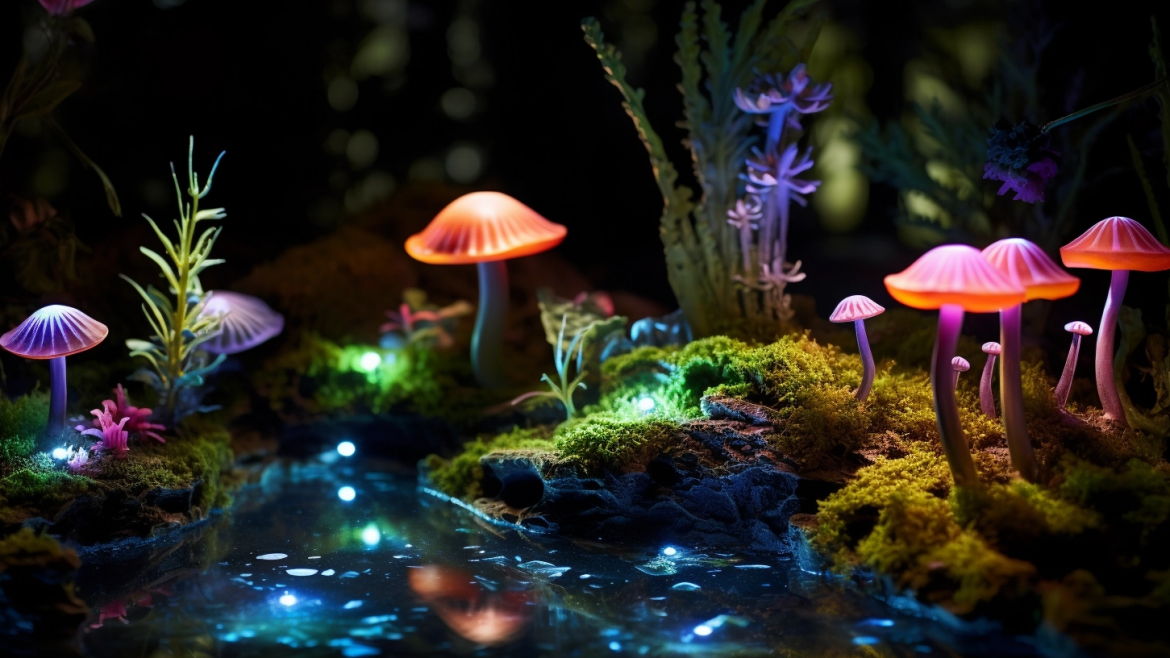A garden can be a sanctuary, a place of tranquility and beauty that offers respite from the chaos of daily life. But imagine a garden that not only delights the senses during daylight hours but also illuminates the night with the ethereal glow of bioluminescent fungi and algae, examples of which can be seen in our introduction to bioluminescent gardens. In this article, we’ll guide you through the process of designing your very own glowing garden—a landscape where nature’s nightlights take center stage, casting their spell over all who venture in.
Planning Your Luminous Landscape
The first step in designing your bioluminescent garden is to carefully consider the layout and how the glowing elements will be integrated with the rest of your landscape. To create a truly enchanting experience, consider these factors:
- Light and Darkness: Striking the perfect balance between light and darkness is essential for a bioluminescent garden. Experiment with different levels of illumination, from soft, subtle glows to more dramatic, intense displays. Incorporate both bioluminescent and traditional plants to create a dynamic, evolving landscape that transforms as day turns to night.
- Focal Points: Create focal points within your garden to draw the eye and highlight the unique beauty of your bioluminescent features. This could include a cluster of glow-in-the-dark mushrooms surrounding a tree, a water feature filled with bioluminescent algae, or a garden sculpture illuminated by a bed of glowing moss.
- Movement: Integrate elements of movement to add an additional layer of magic to your glowing garden. This can be achieved through the use of water features, wind chimes, or swaying plants that catch the light and create mesmerizing patterns of illumination.
- Layers and Textures: Combine various textures and layers to create depth and intrigue within your garden. Consider incorporating a mix of ground cover, shrubs, and trees, as well as different types of bioluminescent fungi and algae, to create a diverse, visually engaging landscape.
Selecting the Right Bioluminescent Organisms
Once you have a clear vision for your glowing garden, it’s time to select the bioluminescent fungi and algae that will bring your design to life. As you explore the various species available, consider factors such as climate, growing conditions, and the desired intensity of light.
Remember to research the specific requirements for each organism, as some may require specific substrates, moisture levels, or temperatures to thrive. By selecting the right organisms and providing the necessary care, you’ll ensure that your glowing garden remains vibrant and healthy for years to come. Again, examples of particular species can be found in our previous article in this series.
Integrating Bioluminescent Features with Traditional Plantings
A well-designed bioluminescent garden seamlessly integrates glowing features with traditional plantings to create a landscape that is both visually stunning and ecologically diverse. Consider incorporating plants with contrasting textures, colors, and forms to create visual interest and enhance the overall impact of your bioluminescent features.
By thoughtfully selecting and arranging your plants, you can create a garden that is not only captivating by night but also a beautiful, serene oasis by day.
Maintaining Your Glowing Garden
A bioluminescent garden requires careful maintenance to ensure that the fungi and algae continue to thrive and emit their ethereal light. Regularly monitor the health of your organisms, and be prepared to adjust their growing conditions as needed. This may involve providing supplemental nutrients, adjusting water levels, or managing pests and diseases.
With the proper care, your glowing garden will serve as a luminous testament to the beauty and diversity of the natural world, captivating all who venture into its enchanted realm.
As you embark on this journey of creating a glowing garden, you’ll discover that the possibilities are truly limitless. The magical interplay between light and darkness, the enchanting array of bioluminescent organisms, and the unique design challenges that come with crafting such a landscape will inspire your creativity and spark your imagination.
As your glowing garden takes shape, remember to embrace the process and enjoy the journey. Allow yourself to be captivated by the beauty of these natural wonders and the way they transform your landscape into an otherworldly oasis that transcends the ordinary.
With your bioluminescent garden now designed and thriving, you may find yourself eager to explore even more ways to enhance and care for your enchanting landscape. In our final article of the series, “Ethereal Glow: Expert Techniques For A Vibrant Bioluminescent Garden,” we delve into the intricacies of caring for and maintaining your luminous paradise. From troubleshooting common issues to uncovering creative solutions, you’ll find a wealth of knowledge to help you keep your glowing garden radiant and healthy for years to come. So, let the magic continue and step into a world where nature’s nightlights illuminate the way.




